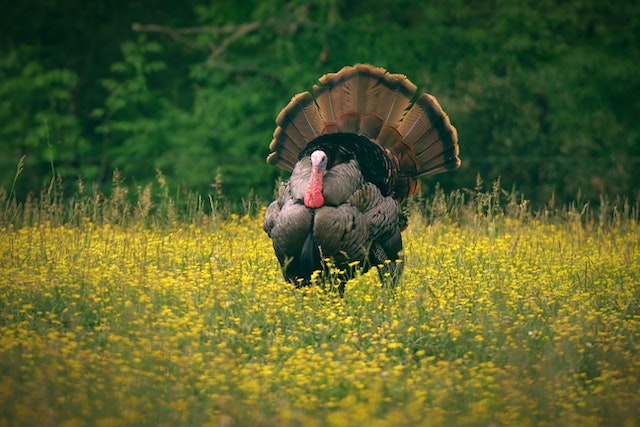Types of Turkey Calls: A Comprehensive Guide to Different Calls for Hunting

Turkey hunting is an exciting and challenging sport that requires skill and patience. One of the most important aspects of turkey hunting is the ability to call in a turkey.
Turkey calls are designed to mimic the sounds that turkeys make in the wild, and there are many different types of turkey calls available to hunters.
Each type of call has its own unique sound and purpose, and choosing the right call can make all the difference when it comes to bagging a bird.
Spring is the most popular time of year for turkey hunting, as this is when the birds are most active and vocal.
During this time, turkeys make a variety of vocalizations to communicate with one another, and hunters can use turkey calls to mimic these sounds and lure birds within range.
There are many different types of turkey calls to choose from, including box calls, slate calls, diaphragm calls, and more.
Each type of call requires a different technique to use effectively, and hunters may need to experiment with several different calls before finding the one that works best for them.
When it comes to turkey calling, there are a few key things to keep in mind. First, it’s important to be patient and persistent. Turkeys can be elusive creatures, and it may take some time to get them to respond to your calls.
Additionally, it’s important to be familiar with the different types of vocalizations that turkeys make, as this will help you choose the right call for the situation.
Finally, it’s important to practice your calling technique regularly, as this will help you develop the skills you need to be successful in the field.
See also “Best turkey calls”
Understanding Turkey Calls
Mouth Calls
Also known as diaphragm calls, mouth calls are a popular type of turkey call. They consist of a latex or rubber reed that is placed inside the mouth, and the caller uses their tongue and breath to create the desired sounds.
Mouth calls are versatile and can produce a wide range of turkey sounds, including yelps, clucks, purrs, and gobbles.
Box Calls
Box calls are another popular type of turkey call. They consist of a wooden box and a striker that is rubbed against the box to create sound.
Box calls can produce a variety of turkey sounds, including yelps, clucks, and purrs. They are relatively easy to use and are a good choice for beginners.
Friction Calls
Friction calls, also known as pot calls or slate calls, consist of a pot or pan made of wood or plastic and a striker made of wood or plastic.
The striker is rubbed against the pot to create sound. Friction calls can produce a variety of turkey sounds, including yelps, clucks, and purrs. They are versatile and can be used in a variety of hunting situations.
Locator Calls
Locator calls are used to locate turkeys and include crow calls, owl hoots, and coyote howls. These calls mimic the sounds of other animals and can be used to get a response from nearby turkeys.
Other Types of Calls
In addition to the above types of calls, there are other types of turkey calls, including glass calls and trumpet calls.
Glass calls consist of a glass surface and a striker made of wood or plastic. Trumpet calls are similar to mouth calls but are designed to produce a more realistic gobble sound.
Overall, understanding the different types of turkey calls and their uses can help hunters be more successful in the field. Whether using a mouth call, box call, friction call, locator call, or other type of call, it’s important to practice and become familiar with the call before heading out on a hunt.
Different Types of Turkey Calls
Yelps
Yelps are the most basic turkey call and are used to get the attention of a turkey. They are made up of a series of quick, high-pitched notes that can be loud or soft depending on the situation. Loud yelps are used to locate turkeys from a distance, while soft yelps are used to call them in close.
Clucks and Purrs
Clucks and purrs are soft, subtle turkey calls that are used to communicate with turkeys that are close by. Clucks are short, sharp notes that are often used to reassure turkeys that everything is safe, while purrs are soft, rolling notes that are used to indicate contentment.
Cutt
The cutt is a high-pitched, staccato turkey call that is used to mimic the sound of a turkey that is excited or agitated. It is often used to get a tom’s attention and can be very effective in getting him to come closer.
Gobbles
Gobbles are the most distinctive turkey call and are used by male turkeys to attract females during the breeding season. They are loud, deep calls that can be heard from a long distance away and are often used to locate toms that are out of sight.
Putts
Putts are short, sharp notes that are used by turkeys to indicate alarm or danger. They are often used by hens to warn their young of potential danger and can be effective in getting a turkey to come closer.
There are many different types of turkey calls available, including diaphragm calls, slate calls, and box calls. Each type of call has its own unique sound and can be used in different situations to attract turkeys.
Whether you are a beginner or an experienced hunter, it is important to choose the right turkey call for the situation and to use it effectively to increase your chances of success.
Using Turkey Calls
When it comes to turkey hunting, using turkey calls can make all the difference. A skilled hunter knows how to use different types of turkey calls to attract their prey. In this section, we will discuss some of the most effective turkey calling techniques.
Calling Techniques
There are several types of turkey calls that hunters use to attract turkeys. Some of the most common types include:
- Box calls
- Diaphragm calls
- Slate calls
- Push-button calls
Each type of call produces a different sound, and hunters often use a combination of calls to create a more realistic effect.
Cadence and Timing
When using turkey calls, cadence and timing are key. Hunters must learn to mimic the sounds that turkeys make, including their rhythm and timing. A skilled hunter will use pauses and breaks in their calling to create a more realistic effect.
Realistic Sounds
Creating realistic sounds is essential when using turkey calls. Hunters must learn to mimic the sounds that turkeys make in the wild, including clucks, purrs, yelps, and gobbles. Using the right call at the right time can make all the difference when trying to attract a turkey.
Turkey Calling Tips for Beginners
For beginners, using turkey calls can be a challenge. However, with practice and patience, anyone can learn to use these calls effectively. Some tips for beginners include:
- Start with a simple call, such as a box call
- Practice regularly to improve your technique
- Listen to recordings of real turkeys to learn their sounds
- Use a variety of calls to create a more realistic effect
- Don’t overcall – sometimes less is more
Turkey Vocalizations
Turkeys are known for their unique and varied vocalizations. These sounds are used to communicate with other turkeys and can be a valuable tool for hunters trying to attract their prey.
Understanding the different types of turkey vocalizations can help hunters better mimic these sounds and increase their chances of success.
Hen Vocalizations
Hens are the most vocal of the turkey species, and their calls are often used to locate other turkeys. The most common hen vocalizations include:
- Cluck: A short, one-note sound often used to get the attention of other turkeys.
- Purr: A soft, rolling sound made when turkeys are content or feeding.
- Cut: A series of quick, sharp notes used to express excitement or alarm.
- Yelp: A series of higher-pitched notes used to communicate with other turkeys over longer distances.
Tom Vocalizations
Toms, or male turkeys, have a deeper and more resonant voice than hens. They use their calls to establish dominance and attract mates. The most common tom vocalizations include:
- Gobble: A loud, distinctive call made by male turkeys to attract females and establish their presence.
- Spit: A low, rolling sound made by male turkeys to show aggression or dominance.
- Drum: A deep, resonant sound made by male turkeys by beating their wings against their body to attract females.
Poult Vocalizations
Poults, or baby turkeys, have a limited range of vocalizations. They use these sounds to communicate with their mothers and siblings. The most common poult vocalizations include:
- Peep: A high-pitched, one-note sound made by baby turkeys to communicate with their mothers.
- Whistle: A soft, two-note sound made by baby turkeys to express contentment or happiness.
Turkey Hunting Strategies
Using Turkey Calls to Locate Birds
One of the most important turkey hunting strategies is to use turkey calls to locate birds. Turkey hunters use different types of calls to attract wild turkeys. Some of the most common calls include soft yelps, clucks, and purrs.
These calls mimic the sounds that turkeys make when they are feeding or communicating with each other.
When using turkey calls to locate birds, hunters should be patient and persistent. They should move slowly and quietly through the woods, stopping frequently to listen for the sounds of turkeys.
Once they hear a turkey, they can use a locator call, such as an owl hoot or crow call, to get the turkey to respond.
Calling Strategies for Different Seasons
Turkey hunting season varies depending on the region, but generally, there are three seasons: spring, fall, and winter.
Each season requires different calling strategies. During the spring mating season, hunters should use soft yelps and purrs to attract toms. In the fall, hunters should use feeding calls to attract flocks of turkeys. During the winter, hunters should use aggressive calls to attract dominant birds.
Aggressive and Dominant Calling
Aggressive and dominant calling is a turkey hunting strategy that is used to attract dominant birds. This type of calling involves using loud, aggressive calls to challenge the dominant bird.
Hunters should use this strategy carefully, as it can scare off less dominant birds. Aggressive and dominant calling is most effective during the winter months when turkeys are more aggressive.
Locating Lost Birds
If a hunter loses track of a turkey, they can use a lost bird call to locate it. This call mimics the sound of a lost or separated turkey, which can attract the lost bird back to the hunter’s location. Hunters should use this call sparingly, as it can also attract predators.
Conclusion
Overall, there are several types of turkey calls that hunters can use to lure in their prey. Each type of call has its own unique sound and purpose, allowing hunters to choose the best option for their specific hunting situation.
Whether using a box call, slate call, mouth call, or locator call, hunters should practice their technique and experiment with different calls to find what works best for them.
When selecting a turkey call, hunters should consider factors such as the terrain, weather conditions, and time of day. They should also be aware of the different sounds that each type of call can produce, and how those sounds can be used to mimic the natural calls of a turkey.
Ultimately, the key to success in turkey hunting is patience, perseverance, and a deep understanding of the animal’s behavior.
By using the right call at the right time, hunters can increase their chances of attracting a turkey and bringing home a successful hunt.
